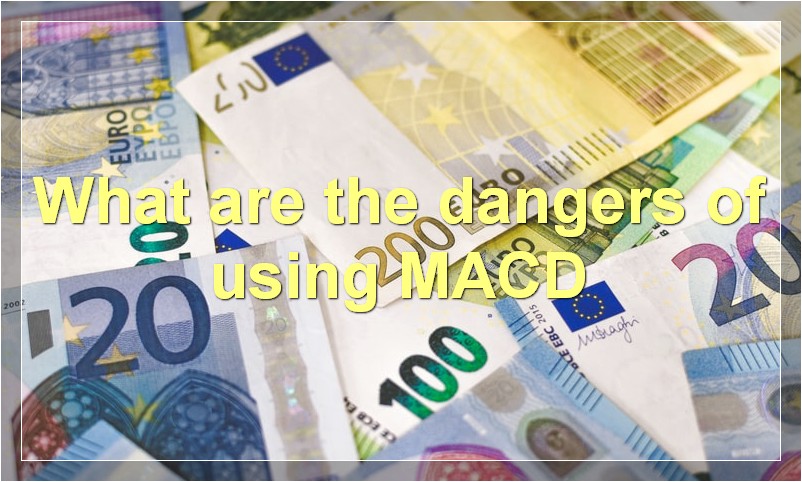If you’re looking to get started with MACD, or just want to brush up on your knowledge, this guide is for you.
How do you calculate MACD
MACD is a technical indicator used by traders to measure momentum. It is calculated by subtracting the 26-day exponential moving average (EMA) from the 12-day EMA.
The MACD histogram is a visual representation of the difference between the MACD line and the signal line. The MACD histogram is positive when the MACD line is above the signal line and negative when the MACD line is below the signal line.
The MACD can be used to identify trend reversals, as well as to measure the strength of a trend. A trader might buy when the MACD histogram is positive and rising, and sell when it is negative and falling.
The MACD can also be used to generate buy and sell signals. A buy signal occurs when the MACD line crosses above the signal line, and a sell signal occurs when the MACD line crosses below the signal line.
What is the MACD formula

The MACD formula is a technical analysis tool that is used to gauge the strength of a stock’s momentum. The formula is calculated by subtracting the 26-day exponential moving average (EMA) from the 12-day EMA. The result is then plotted on a chart along with a 9-day EMA of the MACD line. MACD is considered to be bullish when the MACD line is above the 9-day EMA and bearish when it is below.
How do you interpret MACD signals
MACD signals are one of the most popular technical indicators used by traders. There are three main ways to interpret MACD signals: crossovers, divergences, and histogram.
Crossovers occur when the MACD line crosses above or below the signal line. This is usually seen as a bullish or bearish signal, respectively.
Divergences occur when the MACD line diverges from the price action. This can be seen as a potential reversal signal.
The histogram is a visual representation of the MACD line. It is used to identify trend changes and possible reversals.
What are the benefits of using MACD
The Moving Average Convergence Divergence (MACD) is a trend-following momentum indicator that shows the relationship between two moving averages of a security’s price. The MACD is calculated by subtracting the 26-day exponential moving average (EMA) from the 12-day EMA.
The MACD histogram is used to set up trading signals. A buy signal occurs when the MACD crosses above its signal line, and a sell signal occurs when the MACD crosses below its signal line. The MACD can also be used to identify overbought and oversold conditions.
How does MACD help traders
The MACD, or moving average convergence divergence, is a technical indicator that is used by traders to help identify trends and momentum. The MACD is calculated by subtracting the 26-period exponential moving average (EMA) from the 12-period EMA. A nine-period EMA of the MACD, called the “signal line”, is then plotted on top of the MACD line, which can help trigger trading signals. MACD signals are generated when the MACD line crosses above or below the signal line. A buy signal is generated when the MACD line crosses above the signal line, and a sell signal is generated when the MACD line crosses below the signal line.
The MACD can be used to help traders confirm trends, as well as identify potential reversals. When the MACD line is above the signal line, it indicates that the 12-period EMA is greater than the 26-period EMA, and this generally corresponds with an up trend in prices. Similarly, when the MACD line is below the signal line, it indicates that the 12-period EMA is less than the 26-period EMA, which generally corresponds with a down trend in prices. The MACD can also be used to identify divergences, which can be used as an early warning sign for potential reversals. A bullish divergence occurs when the MACD line moves higher while prices are falling, and a bearish divergence occurs when the MACD line moves lower while prices are rising.
What are the dangers of using MACD

TheMoving Average Convergence Divergence (MACD) is a technical analysis tool that is used to measure momentum. It is also used to signal when a security is overbought or oversold. While the MACD can be a helpful tool, there are also dangers associated with using it.
One of the dangers of using the MACD is that it is a lagging indicator. This means that it can give false signals, especially in a choppy market. The MACD is also susceptible to fakeouts, which can lead to losses.
Another danger of using the MACD is that it relies on past data. This means that it is not necessarily reflective of current conditions. As such, it should not be used as the sole basis for making investment decisions.
Lastly, the MACD is subject to interpretation. Different traders may look at the same chart and come to different conclusions about where the market is headed. This can lead to confusion and possibly bad decision-making.
Despite the dangers, the MACD can still be a helpful tool for traders who understand its limitations and know how to properly use it.
What are the most common mistakes traders make with MACD
There are a few common mistakes traders make when using MACD. One mistake is not accounting for the fact that MACD is a lagging indicator. This means that it can take a while for MACD to signal a change in trend, which can lead to missed opportunities or even losses. Another mistake is not using MACD in conjunction with other technical indicators. MACD works best when used in combination with other indicators such as support and resistance levels or Fibonacci retracements. Finally, some traders use too many settings for MACD, which can result in false signals. It is best to use the default settings or only a few customizations to avoid this problem.
How can you avoid making mistakes with MACD
There is no one perfect way to avoid making mistakes with MACD, but there are a few things you can do to minimize your chances of error. First, make sure you understand the basics of the indicator and how it works. There are many resources available online and in books that can help you with this. Second, be sure to backtest your trading strategy with MACD before implementing it in live markets. This will allow you to see how the indicator performs in different market conditions and can help you identify any potential issues. Finally, don’t be afraid to take some losses when trading with MACD. Like with any other indicator, there will be times when it doesn’t work out as planned. By accepting these losses, you can continue to use MACD without letting it impact your overall trading performance too negatively.
What are some tips for using MACD effectively
There are a few key things to keep in mind when using MACD effectively:
-MACD is best used as a trend-following indicator, so it is important to look for signals in the direction of the current trend.
– MACD signals are most reliable when they occur in alignment with other technical indicators, such as support and resistance levels.
– It is also helpful to use MACD in conjunction with price action analysis.
By following these tips, you can make the most out of MACD and use it to help you make better informed trading decisions.
How do you troubleshoot problems with MACD
When trying to troubleshoot problems with the MACD, it is important to first identify what the problem is. There are three main types of problems that can occur with the MACD: signal line crossover, histogram crossover, and divergence. Once the problem has been identified, there are a few different ways that it can be fixed.
The signal line crossover is the most common type of problem that occurs with the MACD. This happens when the MACD line crosses over the signal line. To fix this problem, you can use a moving average or change the time frame that you are using.
The histogram crossover is another common type of problem that can occur with the MACD. This happens when the histogram crosses over the zero line. To fix this problem, you can use a moving average or change the time frame that you are using.
The last type of problem that can occur with the MACD is divergence. This happens when the MACD line diverges from the price action. To fix this problem, you can use a moving average or change the time frame that you are using.

